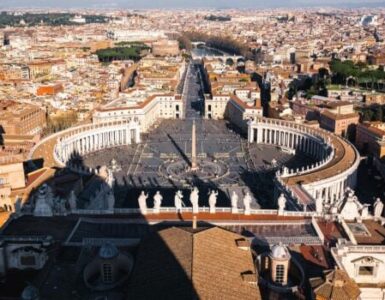Many years ago, Father George L. Thomas knocked on the door of a small rectory at Saint Thomas the Apostle Seminary. Residing there was the Metropolitan of Seattle, Hunthausen. When asked what he was doing before being interrupted by Thomas, he stated “I’m sitting here letting Jesus love me.” In those seven words, Hunthausen revealed a deep truth of ascetical theology.
For many people, Catholics and non-Catholics, prayer is not fully taught. It’s seen as a given.
Several years ago, one of my parish priests, a great mentor, gave me Peter Kreeft’s Prayer for Beginners after lunch. At first, it was a rather shocking gift. In many regards, it seemed insulting prima facie. However, there was great wisdom in his gift. In all my years as a Catholic, I had never been properly taught how to pray, rather viewing it in simple binary. I was always told that prayer is “a conversation with God.” This definition is not wrong, but it can be taken the wrong way.
Prayer is an act of love, and although love is a word, it need not be shown in words. The etymology of the word “conversation” comes from the Latin word conversari, to abide, to live with, or to keep company with. We will soon find that this idea is deeply rooted in the thought of the Church. Certainly the traditional understanding of conversation as a communication through words still exists. This is not to say that speaking in prayer is bad—the scriptures themselves praise this form of worship with the Lord. However, it can go much further.
Love has a certain beauty in its multiplicity of forms. There’s something about an elderly couple deeply in love. After decades of knowing each other better than anyone else, they can look at one another in love in silence. However, the opposite is also exhibited by the love of a mother with her newborn child. Words need not be stated, rather the two are subsisting in the love of the other. To quote Saint Teresa of Lisieux, “For me, prayer is a surge of the heart; it is a simple look turned toward heaven, it is a cry of recognition and of love” (CCC 2558).
There’s a beautiful form of prayer found here. A complete faith in God is exhibited; a complete surrender to His will and goodness is shared without words. We no longer feel the need to barrage God with our desires because we find comfort in Him and His loving understanding.
Psalm 46:10 asks us to “Be still and know that I am God.” The first two words in the Septuagint translation of this verse are simply σχολάσατε (scholasate) the same word used in 1 Corinthians 7:5. The word seems to indicate both concepts of “being free from labor” and “empty.” There seems to be this idea of entirely emptying oneself in fullness and trust to the Lord. Here we illustrate our complete and full trust in Him.
Sitting before the Blessed Sacrament, we are invited into the love of the Trinity in a manner of great depth. I echo Augustine in his profound statement that “The Holy Spirit is the bond of love between the Father and the Son.” This concept was rather strongly encapsulated in Letter to a Suffering Church:
From all eternity, the Father speaks the Son, who is a perfect image of the Father; the Son and the Father look at one another and they fall in love. The love that they breathe back and forth is the Spiritus Sanctus, literally “the holy breath.” Therefore, as G.K. Chesterton observed, the Trinitarian doctrine is simply a technically precise way of saying that God is love. (Robert Barron, Letter to a Suffering Church, 72)
Simply put, there is no way in which we can separate love from God; at His very nature He is love.
This concept is echoed in adoration. Pope Benedict XVI taught, “The Spirit immerses us in the very rhythm of divine life, which is a life of love, enabling us to share personally in relations between the Father and the Son” (Benedict XVI, 15 November 2006). A great deal could be written about the pivotal role of the Holy Spirit in adoration (perhaps a future topic); however, it is through the Holy Spirit, who is the paraclete, that we can truly love God. It is through this love as you look towards the Son and He looks at you that we are echoing the love of the Trinity.

Medieval illuminated manuscripts are often simple pieces of art, especially compared to the Mannerism of Vasari or the Baroque of Caravaggio. However, that does not make them without insight. Several French and English manuscripts in their simplicity provide strong imagery about the nature of the Trinity. Placed into many of the historiated initials are simple images of the Trinity.
A specific early 15th-century breviary known as “Breviary of John the Fearless Margaret of Bavaria” comes to mind. In this image, the Father and the Son are sitting on a shared throne. The two are sitting with their faces inches away, while the father holds the hand of the Son. There are no distractions; we find that the eyes of the Son looking into the eyes of the Father illustrate a profound love. One is drawn to recall Rembrandt’s The Return of the Prodigal Son, as the loving father looks at his beloved son, for this is how the Father looks at us.
In between the Father and the Son floats the Holy Spirit, with His wings being the bridge that conveys the sigh of love from the Father to the Son, the same wings that connect us to the love of God in adoration. Of course, adoration is the closest we will get to the beatific vision on earth. God is both love and immutable; therefore, it should come as no surprise that we find this imagery in Heaven.
In a weekly catechesis, Pope John Paul II described Heaven as “a living, personal relationship with the Holy Trinity. It is our meeting with the Father that takes place in the risen Christ through the communion of the Holy Spirit” (John Paul II, 21 July 1999). Heaven is subsisting and existing in the love of God. That is precisely what occurs when sitting before the Sacrament in silence. We are invited to come to know and love the Lord. Referencing Saint Paul, in Heaven we are “face to face” with the Lord. We sit in a position reflecting the beauty of our creator, we can only sit there awestruck in the greatness of the Lord as He radiates the love that He is. We look upon our creator as He looks upon us. He looks upon us the way an elder brother looks upon his newborn brother, in love and amazement.
Albrecht Dürer’s The Adoration of the Trinity displays Heaven powerfully and purely. Drawing the attention of the viewer is Christ hanging on the cross. This is the eminent example of love. However, it is at the same time that the angels and the saints stare in love at the Son. Instead of harps in the hands of the angels. Dürer paints the instruments of the Lord’s passion. For most of the figures, there is a form of praise only exhibited by the raw and pure love as they examine their crucified Lord in love. There is no music, there is no song, only adoration.

However, it does not end there. Matthäus Landauer, the representation of mankind, is beckoned forth, in this case by a Cardinal—perhaps indicating intersession or just an invitation to come and experience the fullness of love. A love this pure and radical is not something to be kept hidden in the ground, but rather “scattered and sown.”
This same imagery can be found in Albrecht Dürer’s Feast of the Rosary and The Holy Trinity, illustrating a consistent expression of adoration in his work. Although some academics argue that there is a possibility that Dürer may have been Lutheran, the works were finished in 1506 and 1511 which would have been before the inception of Lutheranism. Therefore, a clear and pure Eucharistic ethos would have remained in Dürer’s art at this point.
There is no better way than to end with a story. In his writings, Cardinal Raniero Cantalamessa often recounts a story from the life of Saint John Vianney. During his ministry, the famed Curé d’Ars came upon a laborer who appeared to be constantly in adoration. Intrigued, he asked what he would say to God in his countless hours before the Lord. The man responded with a simple sentence: “Nothing. I look at Him, and He looks at me.”
Images retrieved from Wikimedia Commons and the British Library Archives












